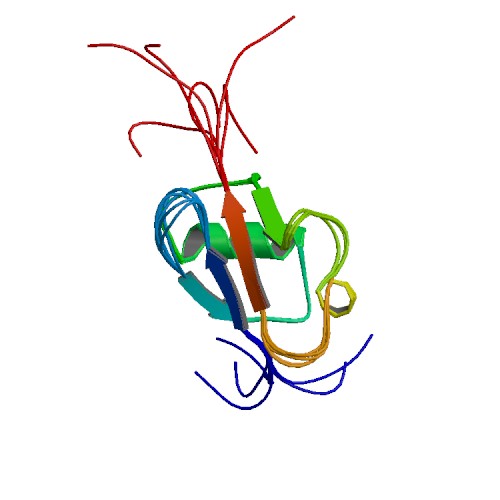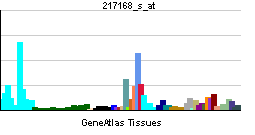HERPUD1
| Homocysteine-inducible, endoplasmic reticulum stress-inducible, ubiquitin-like domain member 1 | |||||||||||||
|---|---|---|---|---|---|---|---|---|---|---|---|---|---|
 PDB rendering based on 1wgd. | |||||||||||||
| |||||||||||||
| Identifiers | |||||||||||||
| Symbols | HERPUD1 ; HERP; KIAA0025; Mif1; SUP | ||||||||||||
| External IDs | Template:OMIM5 Template:MGI HomoloGene: 40973 | ||||||||||||
| |||||||||||||
| RNA expression pattern | |||||||||||||
 | |||||||||||||
| More reference expression data | |||||||||||||
| Orthologs | |||||||||||||
| Template:GNF Ortholog box | |||||||||||||
| Species | Human | Mouse | |||||||||||
| Entrez | n/a | n/a | |||||||||||
| Ensembl | n/a | n/a | |||||||||||
| UniProt | n/a | n/a | |||||||||||
| RefSeq (mRNA) | n/a | n/a | |||||||||||
| RefSeq (protein) | n/a | n/a | |||||||||||
| Location (UCSC) | n/a | n/a | |||||||||||
| PubMed search | n/a | n/a | |||||||||||
Homocysteine-inducible, endoplasmic reticulum stress-inducible, ubiquitin-like domain member 1, also known as HERPUD1, is a human gene.[1]
The accumulation of unfolded proteins in the endoplasmic reticulum (ER) triggers the ER stress response. This response includes the inhibition of translation to prevent further accumulation of unfolded proteins, the increased expression of proteins involved in polypeptide folding, known as the unfolded protein response (UPR), and the destruction of misfolded proteins by the ER-associated protein degradation (ERAD) system. This gene may play a role in both UPR and ERAD. Its expression is induced by UPR and it has an ER stress response element in its promoter region while the encoded protein has an N-terminal ubiquitin-like domain which may interact with the ERAD system. This protein has been shown to interact with presenilin proteins and to increase the level of amyloid-beta protein following its overexpression. Alternative splicing of this gene produces multiple transcript variants, some encoding different isoforms. The full-length nature of all transcript variants has not been determined.[1]
References
Further reading
- van Laar T, van der Eb AJ, Terleth C (2002). "Mif1: a missing link between the unfolded protein response pathway and ER-associated protein degradation?". Curr. Protein Pept. Sci. 2 (2): 169–90. PMID 12370023.
- Nomura N, Miyajima N, Sazuka T; et al. (1995). "Prediction of the coding sequences of unidentified human genes. I. The coding sequences of 40 new genes (KIAA0001-KIAA0040) deduced by analysis of randomly sampled cDNA clones from human immature myeloid cell line KG-1". DNA Res. 1 (1): 27–35. PMID 7584026.
- Maruyama K, Sugano S (1994). "Oligo-capping: a simple method to replace the cap structure of eukaryotic mRNAs with oligoribonucleotides". Gene. 138 (1–2): 171–4. PMID 8125298.
- Andersson B, Wentland MA, Ricafrente JY; et al. (1996). "A "double adaptor" method for improved shotgun library construction". Anal. Biochem. 236 (1): 107–13. doi:10.1006/abio.1996.0138. PMID 8619474.
- Yu W, Andersson B, Worley KC; et al. (1997). "Large-scale concatenation cDNA sequencing". Genome Res. 7 (4): 353–8. PMID 9110174.
- Suzuki Y, Yoshitomo-Nakagawa K, Maruyama K; et al. (1997). "Construction and characterization of a full length-enriched and a 5'-end-enriched cDNA library". Gene. 200 (1–2): 149–56. PMID 9373149.
- van Laar T, Schouten T, Hoogervorst E; et al. (2000). "The novel MMS-inducible gene Mif1/KIAA0025 is a target of the unfolded protein response pathway". FEBS Lett. 469 (1): 123–31. PMID 10708769.
- Kokame K, Agarwala KL, Kato H, Miyata T (2000). "Herp, a new ubiquitin-like membrane protein induced by endoplasmic reticulum stress". J. Biol. Chem. 275 (42): 32846–53. doi:10.1074/jbc.M002063200. PMID 10922362.
- Kokame K, Kato H, Miyata T (2001). "Identification of ERSE-II, a new cis-acting element responsible for the ATF6-dependent mammalian unfolded protein response". J. Biol. Chem. 276 (12): 9199–205. doi:10.1074/jbc.M010486200. PMID 11112790.
- Sai X, Kawamura Y, Kokame K; et al. (2002). "Endoplasmic reticulum stress-inducible protein, Herp, enhances presenilin-mediated generation of amyloid beta-protein". J. Biol. Chem. 277 (15): 12915–20. doi:10.1074/jbc.M112372200. PMID 11799129.
- Chtarbova S, Nimmrich I, Erdmann S; et al. (2002). "Murine Nr4a1 and Herpud1 are up-regulated by Wnt-1, but the homologous human genes are independent from beta-catenin activation". Biochem. J. 367 (Pt 3): 723–8. doi:10.1042/BJ20020699. PMID 12153396.
- Strausberg RL, Feingold EA, Grouse LH; et al. (2003). "Generation and initial analysis of more than 15,000 full-length human and mouse cDNA sequences". Proc. Natl. Acad. Sci. U.S.A. 99 (26): 16899–903. doi:10.1073/pnas.242603899. PMID 12477932.
- Sai X, Kokame K, Shiraishi H; et al. (2003). "The ubiquitin-like domain of Herp is involved in Herp degradation, but not necessary for its enhancement of amyloid beta-protein generation". FEBS Lett. 553 (1–2): 151–6. PMID 14550564.
- Gerhard DS, Wagner L, Feingold EA; et al. (2004). "The status, quality, and expansion of the NIH full-length cDNA project: the Mammalian Gene Collection (MGC)". Genome Res. 14 (10B): 2121–7. doi:10.1101/gr.2596504. PMID 15489334.
- Rual JF, Venkatesan K, Hao T; et al. (2005). "Towards a proteome-scale map of the human protein-protein interaction network". Nature. 437 (7062): 1173–8. doi:10.1038/nature04209. PMID 16189514.
- Schulze A, Standera S, Buerger E; et al. (2006). "The ubiquitin-domain protein HERP forms a complex with components of the endoplasmic reticulum associated degradation pathway". J. Mol. Biol. 354 (5): 1021–7. doi:10.1016/j.jmb.2005.10.020. PMID 16289116.
- Lim J, Hao T, Shaw C; et al. (2006). "A protein-protein interaction network for human inherited ataxias and disorders of Purkinje cell degeneration". Cell. 125 (4): 801–14. doi:10.1016/j.cell.2006.03.032. PMID 16713569.
- Liang G, Audas TE, Li Y; et al. (2007). "Luman/CREB3 induces transcription of the endoplasmic reticulum (ER) stress response protein Herp through an ER stress response element". Mol. Cell. Biol. 26 (21): 7999–8010. doi:10.1128/MCB.01046-06. PMID 16940180.
- Lenz B, Bleich S, Beutler S; et al. (2007). "Homocysteine regulates expression of Herp by DNA methylation involving the AARE and CREB binding sites". Exp. Cell Res. 312 (20): 4049–55. doi:10.1016/j.yexcr.2006.09.004. PMID 17020760.
| This protein-related article is a stub. You can help Wikipedia by expanding it. |